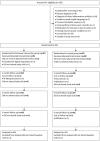Effects of a footwear intervention on foot pain and disability in people with gout: a randomised controlled trial
- PMID: 31018869
- PMCID: PMC6480516
- DOI: 10.1186/s13075-019-1886-y
Effects of a footwear intervention on foot pain and disability in people with gout: a randomised controlled trial
Abstract
Background: There is limited evidence supporting the long-term effect of a foot care package that includes footwear for people with gout. The aim of this study was to investigate the effectiveness of a footwear intervention on foot pain and disability in people with gout over 6 months.
Methods: Participants with gout (n = 94) were randomly allocated to either a control group (podiatric care and gout education) or footwear intervention group (podiatric care and gout education plus a commercially available athletic shoe). Measurements were undertaken at baseline and 2, 4, and 6 months. Primary outcome was foot pain severity. Secondary outcomes were overall pain, foot impairment/disability, footwear comfort, fit, ease and weight. Data were analysed using repeated measures models.
Results: Baseline foot pain scores were low, and no differences in foot pain scores were observed between groups over 6 months (adjusted effect estimate: - 6.7, 95% CI - 16.4 to 2.9, P = 0.17). Improvements between groups in overall pain scores (adjusted effect estimate: - 13.2, 95% CI - 22.2 to - 4.3, P < 0.01) and foot impairment/disability scores (- 4.7, 95% CI - 9.1 to - 0.3, P = 0.04) favouring the footwear intervention were observed at 2 months, but not at 4 or 6 months. Improvements between groups in footwear fit (adjusted effect estimate: - 11.1, 95% CI - 21.1 to - 1.0, P = 0.03), ease (- 13.2, 95% CI - 23.8 to - 2.7, P = 0.01) and weight (- 10.3, 95% CI - 19.8 to - 0.8, P = 0.03) favouring the footwear intervention were also observed over 6 months. Similar improvements were observed for footwear comfort at 2 and 4 months. No other differences in secondary outcomes measured were observed at 6 months (P > 0.05).
Conclusions: Addition of footwear to a foot care package did not improve foot pain in people with gout. Short-term improvements in overall pain and foot impairment/disability and more durable improvements in footwear comfort and fit were observed with the footwear intervention.
Trial registration: ACTRN12614000209695. Registered 27 February 2014, http://www.anzctr.org.au/TrialSearch.aspx?searchTxt=ACTRN12614000209695&isBasic=True.
Keywords: Foot; Foot pain; Footwear; Gout.
Conflict of interest statement
Ethics approval and consent to participate
The trial was approved by the New Zealand Ministry of Health, Health and Disability Ethics Committees (14/CEN/117) and all participants provided written informed consent.
Consent for publication
Not applicable.
Competing interests
N. D. has received consulting fees, speaker fees or grants from Takeda, Teijin, Menarini, Amgen, Ardea Biosciences, AstraZeneca, Horizon, Cymabay and Kowa, outside the submitted work. K. R. has received funding from ASICS, outside the submitted work. ASICS had no role in the design of the study. The footwear used in the study was purchased at retail price. The other authors declare that they have no competing interests.
Publisher’s Note
Springer Nature remains neutral with regard to jurisdictional claims in published maps and institutional affiliations.
Figures
References
-
- Rome K, Erikson K, Ng A, Gow PJ, Sahid H, Williams AE. A new podiatry service for patients with arthritis. NZ Med J. 2013;126:70–77. - PubMed
Publication types
MeSH terms
Associated data
LinkOut - more resources
Full Text Sources
Medical



